A Geospatial Framework for Spatiotemporal Crash Hotspot Detection Using Space–Time Cube Modeling and Emerging Pattern Analysis
Abstract
1. Introduction
- Analyze the spatial distribution and the temporal trends of crashes over the corridor during the study period.
- Identify and classify crash hotspots using STC analysis, Moran’s I, and EHA.
- Assess the statistical significance of crash clustering.
- Develop a methodological framework to support decision making in resource allocation.
- It advances the understanding of crash patterns from static to dynamic classification.
- It extends the application of spatiotemporal GIS-based methods to a major interstate corridor level.
- It provides a robust framework to help decision-makers and traffic management centers identify future improvements and road safety priorities to ensure efficient resource distribution.
- It establishes a transferable framework that can be generalized to similar networks in other states.
2. Literature Review
3. Materials and Methods
3.1. Data Preparation
3.2. Methodology
3.2.1. Crash Hotspot Analysis
3.2.2. STC Analysis
3.2.3. Global Spatial Autocorrelation Analysis
- is the attribute value of feature j;
- is the spatial weight between feature i and j;
- is the total number of features;
- is the mean of attribute values;
- is the standard deviation of attribute values.
3.2.4. Emerging Hotspot Analysis
4. Results and Discussion
4.1. Descriptive Analysis
4.2. Spatial Clustering Analysis
4.3. Emerging Hotspot Analysis (EHA)
- Persistent hotspots are locations that have been statistically significant and consistent over consecutive intervals, and, therefore, they will require more investment in their mitigation strategies.
- Intensifying hotspots, where the concentration of crashes increases over time, suggest a growing safety concern that requires priority intervention before they become persistent.
- Sporadic hotspots appear irregularly over time and, therefore, require tailored safety strategies.
- Diminishing hotspots with a declining crash concentration over time indicate effective application of prior safety improvement, so they require less attention compared to other categories.
- New hotspots are locations that recently became statistically significant. Identifying new hotspot locations is critical, enabling agencies to proactively mitigate these new areas before they escalate.
4.4. Three-Dimensional Space–Time Crash Trend Visualization
5. Conclusions and Future Recommendations
Author Contributions
Funding
Institutional Review Board Statement
Informed Consent Statement
Data Availability Statement
Acknowledgments
Conflicts of Interest
References
- World Health Organization. Global Status Report on Road Safety 2023; World Health Organization: Geneva, Switzerland, 2023. [Google Scholar]
- Hauer, E. Observational Before-After Studies in Road Safety: Estimating the Effect of Highway and Traffic Engineering Measures on Road Safety; Pergamon: Amsterdam, The Netherlands, 2007; p. 306. Available online: http://worldcat.org/isbn/0080430538 (accessed on 23 July 2025).
- Pantangi, S.S.; Fountas, G.; Sarwar, M.T.; Bhargava, A.; Mohan, S.B.; Savolainen, P.; Anastasopoulos, P.C. The impact of public–private partnerships for roadway projects on traffic safety: An exploratory empirical analysis of crash frequencies. Anal. Methods Accid. Res. 2022, 33, 100192. [Google Scholar] [CrossRef]
- Lord, D.; Mannering, F. The statistical analysis of crash-frequency data: A review and assessment of methodological alternatives. Transp. Res. Part A Policy Pract. 2010, 44, 291–305. [Google Scholar] [CrossRef]
- Deljouyi, N.; Patnala, P.K.; Mehran, B.; Regehr, J.D. Application of reliability models for crash frequency analysis: Implications for network-wide safety performance. Can. J. Civ. Eng. 2024, 52, 60–73. [Google Scholar] [CrossRef]
- Guo, X.; Wu, L.; Zou, Y.; Fawcett, L. Comparative Analysis of Empirical Bayes and Bayesian Hierarchical Models in Hotspot Identification. Transp. Res. Rec. 2019, 2673, 111–121. [Google Scholar] [CrossRef]
- Howlader, M.M.; Yasmin, S.; Bhaskar, A.; Haque, M.M. A before-after evaluation of protected right-turn signal phasings by applying Empirical Bayes and Full Bayes approaches with heterogenous count data models. Accid. Anal. Prev. 2023, 179, 106882. [Google Scholar] [CrossRef] [PubMed]
- Al-Kaisy, A.; Huda, K.T. Empirical Bayes application on low-volume roads: Oregon case study. J. Saf. Res. 2022, 80, 226–234. [Google Scholar] [CrossRef]
- Florida Transportation Plan Policy Element Strategic Intermodal System (SIS) Policy Plan. Available online: www.floridatransportationplan.com (accessed on 23 July 2025).
- Li, L.; Zhu, L.; Sui, D.Z. A GIS-based Bayesian approach for analyzing spatial-temporal patterns of intra-city motor vehicle crashes. J. Transp. Geogr. 2007, 15, 274–285. [Google Scholar] [CrossRef]
- Iamtrakul, P.; Chayphong, S. GIS-based analysis of spatio-temporal clustering of road traffic accidents in Bangkok Metropolitan Region (BMR), Thailand from 2012 to 2021. Transp. Res. Interdiscip. Perspect. 2025, 31, 101489. [Google Scholar] [CrossRef]
- Vemulapalli, S.S.; Ulak, M.B.; Ozguven, E.E.; Sando, T.; Horner, M.W.; Abdelrazig, Y.; Moses, R. GIS-based Spatial and Temporal Analysis of Aging-Involved Accidents: A Case Study of Three Counties in Florida. Appl. Spat. Anal. Policy 2017, 10, 537–563. [Google Scholar] [CrossRef]
- Mohaymany, A.S.; Shahri, M.; Mirbagheri, B. GIS-based method for detecting high-crash-risk road segments using network kernel density estimation. Geo-Spat. Inf. Sci. 2013, 16, 113–119. [Google Scholar] [CrossRef]
- Feizizadeh, B.; Omarzadeh, D.; Sharifi, A.; Rahmani, A.; Lakes, T.; Blaschke, T. A GIS-Based Spatiotemporal Modelling of Urban Traffic Accidents in Tabriz City during the COVID-19 Pandemic. Sustainability 2022, 14, 7468. [Google Scholar] [CrossRef]
- Sae-Ngow, P.; Kulpanich, N.; Worachairungreung, M.; Sittarachu, N.; Thanakunwutthirot, K.; Hemwan, P. Identification of road crash zones, spatial patterns, and emerging hot spots of road traffic injury severity in Phuket, Thailand. Geoj. Tour. Geosites 2025, 60, 1067–1077. [Google Scholar] [CrossRef]
- Desktop GIS Software. Mapping Analytics. ArcGIS Pro. Available online: https://www.esri.com/en-us/arcgis/products/arcgis-pro/overview (accessed on 23 July 2025).
- Rao, S. Traffic safety engineering and crash analysis methods. Int. J. Sci. Res. Arch. 2025, 15, 158–165. [Google Scholar] [CrossRef]
- Paliotto, A.; Meocci, M.; Terrosi, A.; La Torre, F. Systematic review, evaluation and comparison of different approaches for the implementation of road network safety analysis. Heliyon 2024, 10, e28391. [Google Scholar] [CrossRef] [PubMed]
- Abdulhafedh, A. Road Crash Prediction Models: Different Statistical Modeling Approaches. J. Transp. Technol. 2017, 07, 190–205. [Google Scholar] [CrossRef]
- Alazab, A.; Venkatraman, S.; Abawajy, J.; Alazab, M. An Optimal Transportation Routing Approach using GIS-based Dynamic Traffic Flows. In Proceedings of the 3rd International Conference on Information and Financial Engineering IPEDR, Singapore, 26–27 February 2011; IACSIT Press: Singapore, 2011; Volume 12, pp. 172–178. [Google Scholar]
- Lepofsky, M.; Abkowitz, M.; Cheng, P. Transportation hazard analysis in integrated GIS environment. J. Transp. Eng. 1993, 119, 239–254. [Google Scholar] [CrossRef]
- Kazmi, S.S.A.; Mumtaz, R.; Anwar, Z.; Ahmed, M. Spatiotemporal Clustering and Analysis of Road Accident Hotspots by Exploiting GIS Technology and Kernel Density Estimation. Comput. J. 2020, 65, 155–176. [Google Scholar] [CrossRef]
- Amiri, A.M.; Nadimi, N.; Khalifeh, V.; Shams, M. GIS-based crash hotspot identification: A comparison among mapping clusters and spatial analysis techniques. Int. J. Inj. Control. Saf. Promot. 2021, 28, 325–338. [Google Scholar] [CrossRef]
- Tulloch, D.L.; Myers, J.R.; Hasse, J.E.; Parks, P.J.; Lathrop, R.G. Integrating GIS into farmland preservation policy and decision making. Landsc. Urban Plan. 2003, 63, 33–48. [Google Scholar] [CrossRef]
- Kim, D.; Chae, M. GIS for a Policy Decision Support in National Tourism Portal. In Proceedings of the 24th Annual ESRI User Conference, San Diego, CA, USA, 9–13 August 2004. [Google Scholar]
- Terh, S.H.; Cao, K. GIS-MCDA based cycling paths planning: A case study in Singapore. Appl. Geogr. 2018, 94, 107–118. [Google Scholar] [CrossRef]
- Huang, B. GIS-Based Route Planning for Hazardous Material Transportation. J. Environ. Inform. 2006, 8, 49–57. [Google Scholar] [CrossRef]
- Arampatzis, G.; Kiranoudis, C.T.; Scaloubacas, P.; Assimacopoulos, D. A GIS-based decision support system for planning urban transportation policies. Eur. J. Oper. Res. 2004, 152, 465–475. [Google Scholar] [CrossRef]
- Hazaymeh, K.; Almagbile, A.; Alomari, A.H.; Hazaymeh, K.; Almagbile, A.; Alomari, A.H. Spatiotemporal Analysis of Traffic Accidents Hotspots Based on Geospatial Techniques. ISPRS Int. J. Geo-Inf. 2022, 11, 260. [Google Scholar] [CrossRef]
- Alam, M.S.; Tabassum, N.J. Spatial pattern identification and crash severity analysis of road traffic crash hot spots in Ohio. Heliyon 2023, 9, e16303. [Google Scholar] [CrossRef] [PubMed]
- Cantisani, G.; Peluso, P.; Pompigna, A.; Serrone, G.D. A GIS-based methodology to observe driver behaviors and infrastructure characteristics through operating speeds. Transp. Res. Procedia 2025, 90, 416–423. [Google Scholar] [CrossRef]
- Harirforoush, H.; Bellalite, L. A new integrated GIS-based analysis to detect hotspots: A case study of the city of Sherbrooke. Accid. Anal. Prev. 2019, 130, 62–74. [Google Scholar] [CrossRef]
- Moreno-Ponce, L.A.; Pérez-Zuriaga, A.M.; García, A. Predictive Models and GIS for Road Safety: Application to a Segment of the Chone–Flavio Alfaro Road. Sustainability 2025, 17, 5032. [Google Scholar] [CrossRef]
- Zhang, Y.; Zhu, F.; Li, Q.; Qiu, Z.; Xie, Y. Exploring Spatiotemporal Patterns of Expressway Traffic Accidents Based on Density Clustering and Bayesian Network. ISPRS Int. J. Geo-Inf. 2023, 12, 73. [Google Scholar] [CrossRef]
- Wang, D.; Krebs, E.; Nickenig Vissoci, J.R.; de Andrade, L.; Rulisa, S.; Staton, C.A. Built Environment Analysis for Road Traffic Crash Hotspots in Kigali, Rwanda. Front. Sustain. Cities 2020, 2, 17. [Google Scholar] [CrossRef]
- Zubaidi, H.; Obaid, I.; Mohammed, H.A.; Das, S.; Al-Bdairi, N.S.S. Hot spot analysis of the crash locations at the roundabouts through the application of GIS. J. Phys. Conf. Ser. 2021, 1895, 012032. [Google Scholar] [CrossRef]
- Gedamu, W.T.; Plank-Wiedenbeck, U.; Wodajo, B.T. Spatio-temporal analysis of road traffic crashes by severity. Transp. Eng. 2025, 20, 100327. [Google Scholar] [CrossRef]
- Alsahfi, T. Spatial and Temporal Analysis of Road Traffic Accidents in Major Californian Cities Using a Geographic Information System. ISPRS Int. J. Geo-Inf. 2024, 13, 157. [Google Scholar] [CrossRef]
- Wang, S.; Gao, K.; Zhang, L.; Yu, B.; Easa, S.M. Geographically weighted machine learning for modeling spatial heterogeneity in traffic crash frequency and determinants in US. Accid. Anal. Amp; Prev. 2024, 199, 107528. [Google Scholar] [CrossRef]
- Iranitalab, A.; Khattak, A. Comparison of four statistical and machine learning methods for crash severity prediction. Accid. Anal. Prev. 2017, 108, 27–36. [Google Scholar] [CrossRef]
- Ding, C.; Chen, P.; Jiao, J. Non-linear effects of the built environment on automobile-involved pedestrian crash frequency: A machine learning approach. Accid. Anal. Prev. 2018, 112, 116–126. [Google Scholar] [CrossRef]
- Karimi Monsefi, A.; Shiri, P.; Mohammadshirazi, A.; Karimi Monsefi, N.; Davies, R.; Moosavi, S.; Ramnath, R. CrashFormer: A Multimodal Architecture to Predict the Risk of Crash. In Proceedings of the UrbanAI ‘23: 1st ACM SIGSPATIAL International Workshop on Advances in Urban-AI, Hamburg, Germany, 13 November 2023; Association for Computing Machinery: New York, NY, USA, 2023; pp. 42–51. [Google Scholar] [CrossRef]
- Zhao, L.; Li, F.; Sun, D.; Dai, F. Highway Traffic Crash Risk Prediction Method considering Temporal Correlation Characteristics. J. Adv. Transp. 2023, 2023, 9695433. [Google Scholar] [CrossRef]
- Wang, X.; Su, Y.; Zheng, Z.; Xu, L. Prediction and interpretive of motor vehicle traffic crashes severity based on random forest optimized by meta-heuristic algorithm. Heliyon 2024, 10, e35595. [Google Scholar] [CrossRef]



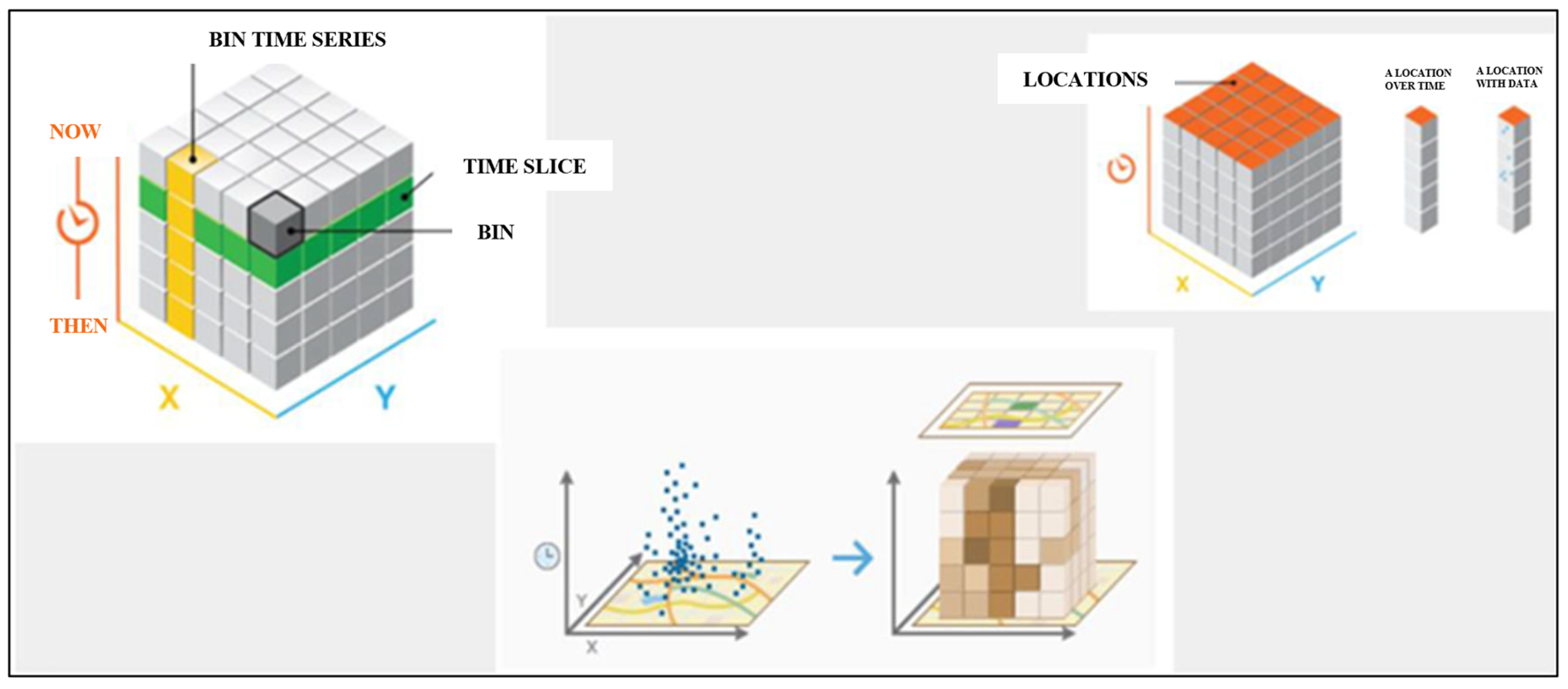
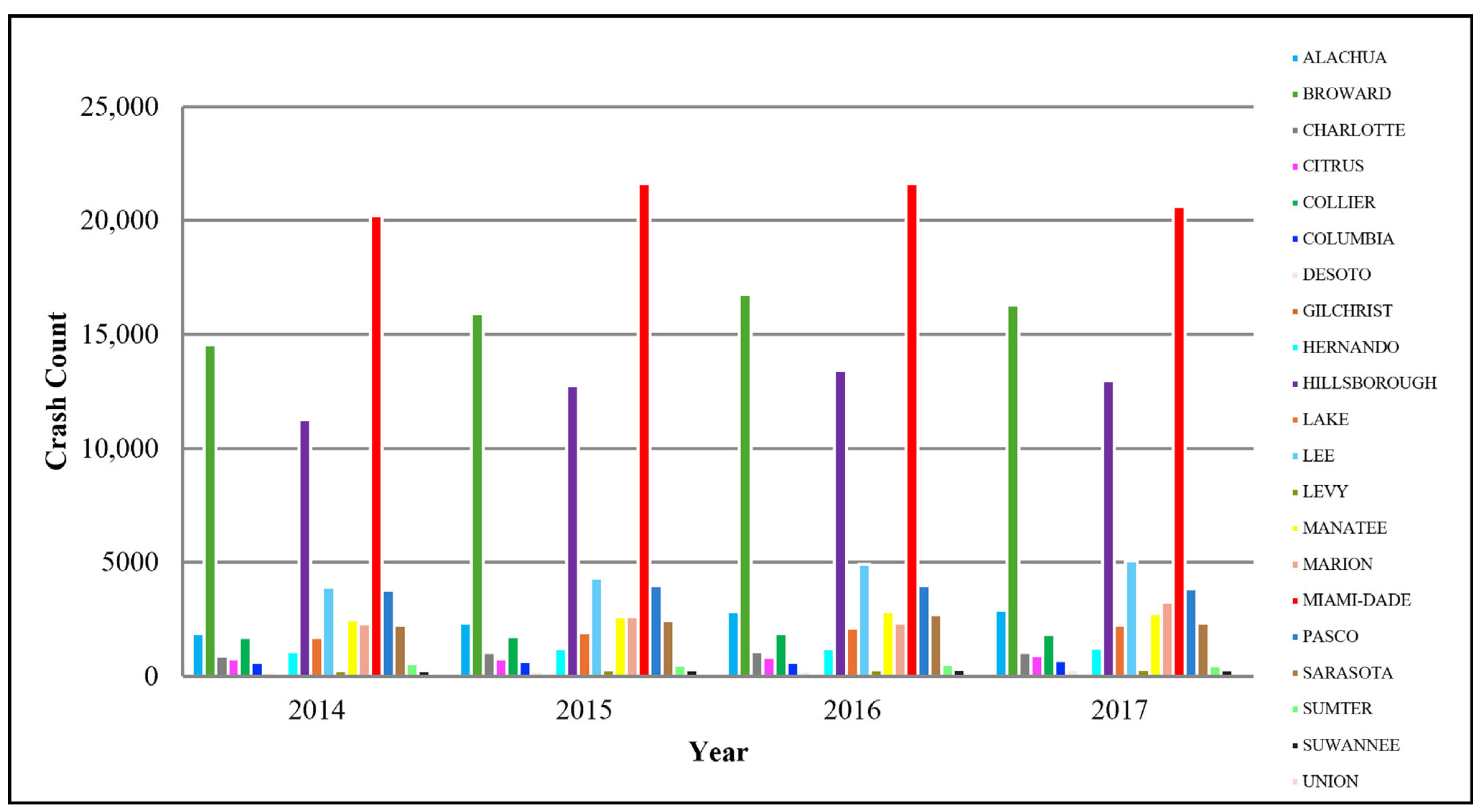

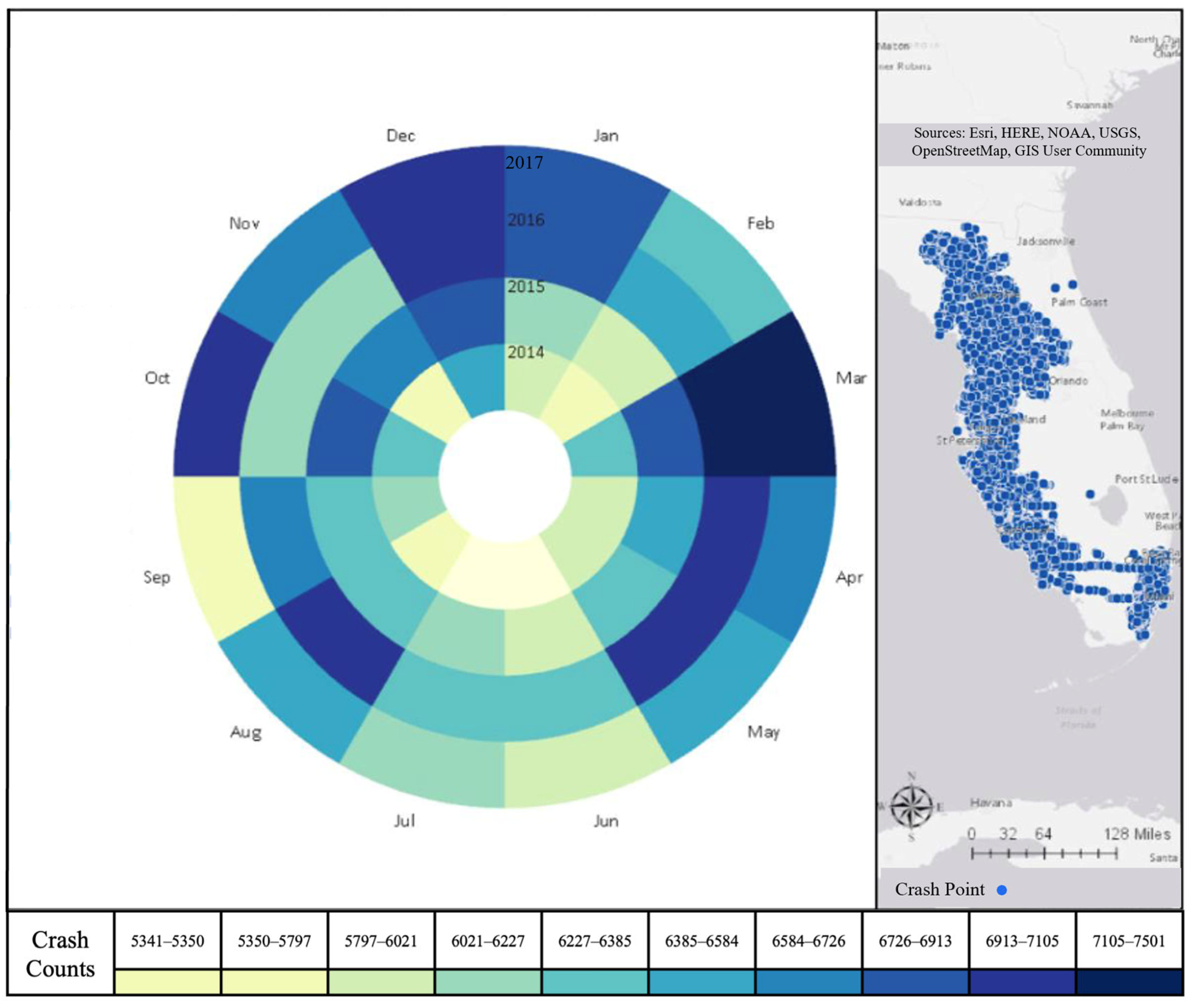
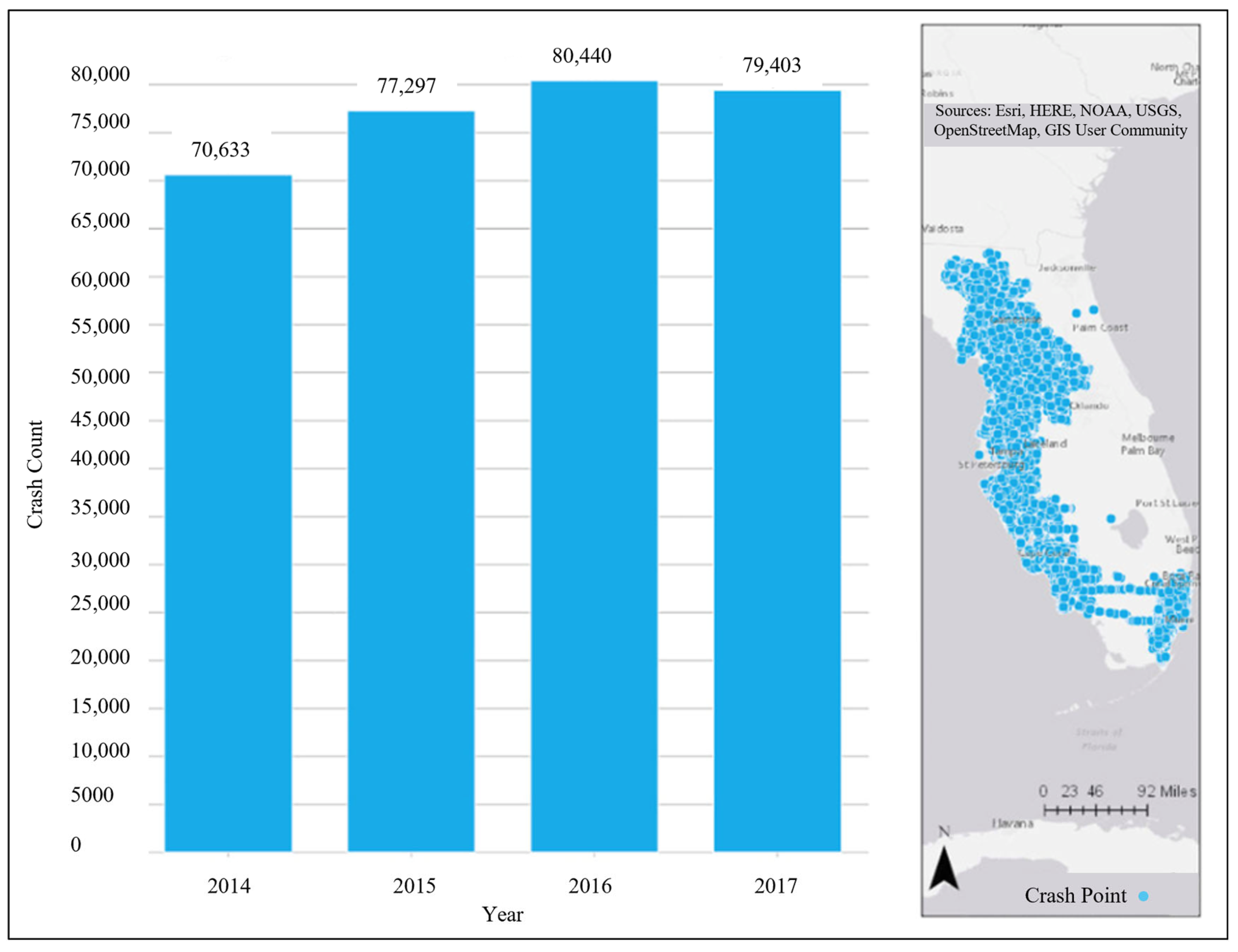
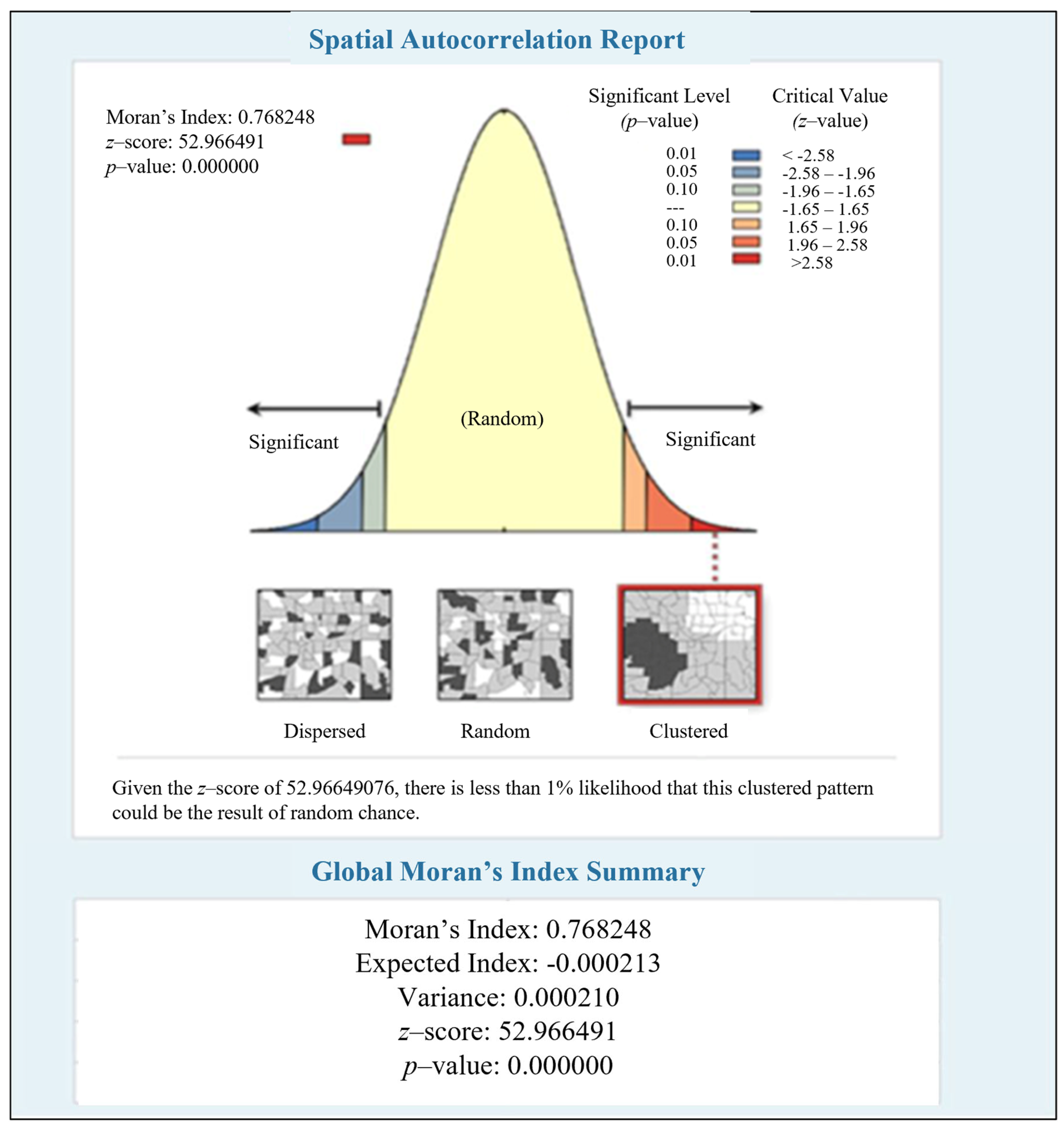


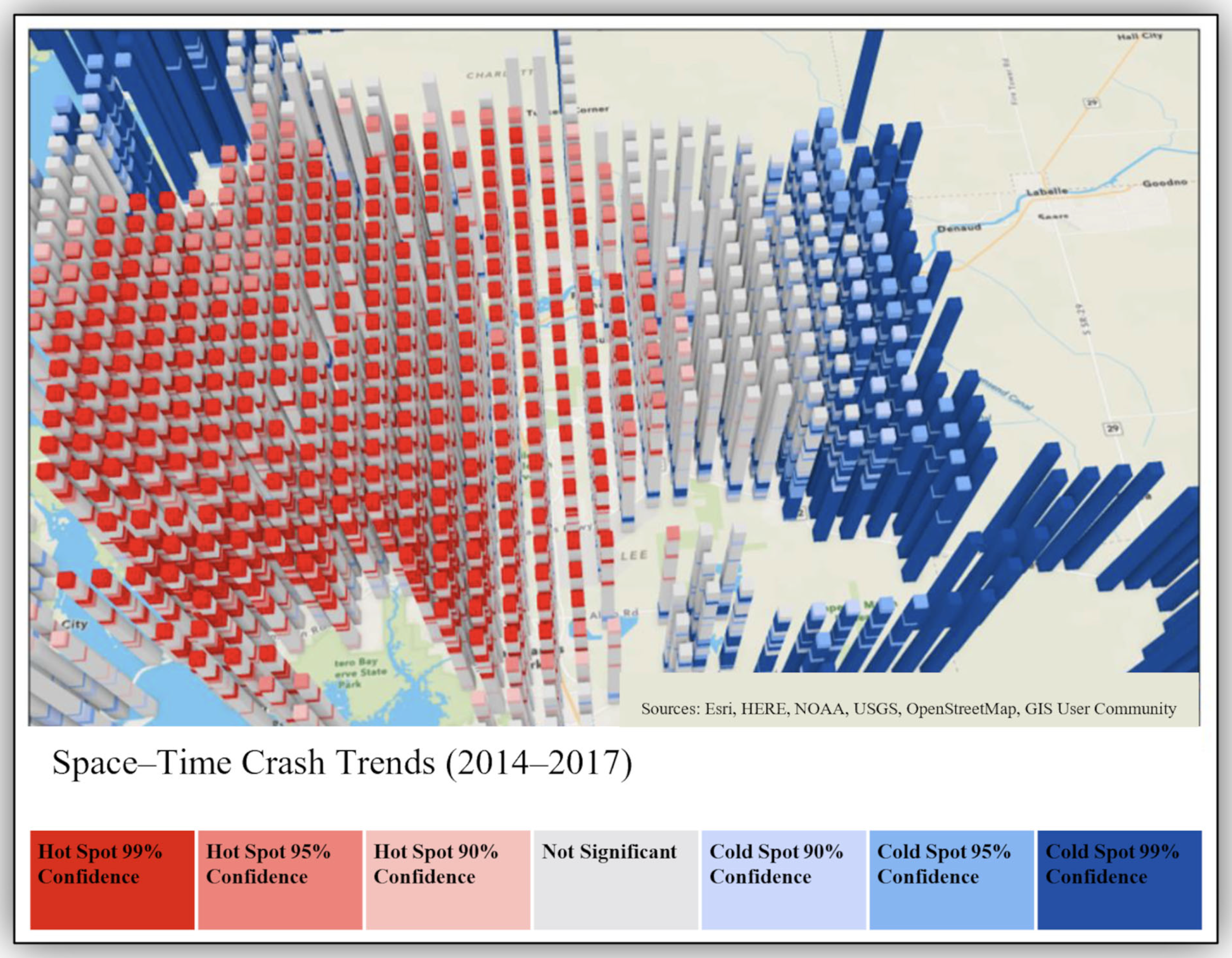
| Research Objectives | Corresponding Methods | Data Requirements | Expected Outputs |
|---|---|---|---|
| Spatiotemporal analysis of crash patterns and 3D visualization | STC analysis, 3D visualization of temporal crash trends | Monthly crash records with geolocation (latitude, longitude), timestamp, and roadway ID for the study period | Identification of crash temporal patterns, understanding of crash spatial distribution, and crash trends visualization |
| Identify and classify crash hotspots | Global spatial autocorrelation (Moran’s I), EHA (Getis-Ord Gi statistic) | Crash records with spatial coordinates and temporal attributes | Classification of hotspots into categories, crash trends over time, and statistical significance levels |
| Assess the statistical analysis of the crash distribution | z-score calculations, p-value determination, confidence level assessment | Crash frequency counts aggregated by roadway segments. Spatial weight matrix to define neighborhood relationships between segments | Validation of crash spatial patterns |
| Develop a framework to support decision-making in resource allocation | Crash pattern analysis and crash trend interpretation, resource allocation assessment | Hotspot classification results combined with statistical output (Moran’s I, z-score, p-value) | Prioritize financial resources more effectively, and safety improvement recommendations |
| County | Crash During Study Period (2014–2017) |
|---|---|
| Alachua | 9908 |
| Broward | 63,510 |
| Charlotte | 4048 |
| Citrus | 3230 |
| Collier | 7128 |
| Columbia | 2541 |
| Desoto | 859 |
| Gilchrist | 319 |
| Hernando | 4691 |
| Hillsborough | 50,377 |
| Lake | 7967 |
| Lee | 18,186 |
| Levy | 1082 |
| Manatee | 10,676 |
| Marion | 10,499 |
| Miami-Dade | 84,100 |
| Pasco | 15,577 |
| Sarasota | 9700 |
| Sumter | 2030 |
| Suwannee | 1084 |
| Union | 261 |
| Hotspot Category | Definition | Location |
|---|---|---|
| Persistent hotspot | Statistically significant hotspot for most of the 4-year study period | Miami-Dade and Hillsborough counties (major freight hubs and urban areas) |
| Intensifying hotspot | Increasing crash concentration with each successive time step | Near Tampa, Fort Myers, Broward County |
| New hotspot | Recently became statistically significant | Near Paseo, Manatee, and Collier counties |
| Sporadic hotspot | Hotspots appear irregularly over time | Rural areas of Colombia, Hernando, and Citrus counties |
| Diminishing hotspot | Previously a hotspot but declined over time | North segments Union, Gilchrist, and Levy counties |
Disclaimer/Publisher’s Note: The statements, opinions and data contained in all publications are solely those of the individual author(s) and contributor(s) and not of MDPI and/or the editor(s). MDPI and/or the editor(s) disclaim responsibility for any injury to people or property resulting from any ideas, methods, instructions or products referred to in the content. |
© 2025 by the authors. Licensee MDPI, Basel, Switzerland. This article is an open access article distributed under the terms and conditions of the Creative Commons Attribution (CC BY) license (https://creativecommons.org/licenses/by/4.0/).
Share and Cite
Younes, S.; Oloufa, A. A Geospatial Framework for Spatiotemporal Crash Hotspot Detection Using Space–Time Cube Modeling and Emerging Pattern Analysis. Urban Sci. 2025, 9, 411. https://doi.org/10.3390/urbansci9100411
Younes S, Oloufa A. A Geospatial Framework for Spatiotemporal Crash Hotspot Detection Using Space–Time Cube Modeling and Emerging Pattern Analysis. Urban Science. 2025; 9(10):411. https://doi.org/10.3390/urbansci9100411
Chicago/Turabian StyleYounes, Samar, and Amr Oloufa. 2025. "A Geospatial Framework for Spatiotemporal Crash Hotspot Detection Using Space–Time Cube Modeling and Emerging Pattern Analysis" Urban Science 9, no. 10: 411. https://doi.org/10.3390/urbansci9100411
APA StyleYounes, S., & Oloufa, A. (2025). A Geospatial Framework for Spatiotemporal Crash Hotspot Detection Using Space–Time Cube Modeling and Emerging Pattern Analysis. Urban Science, 9(10), 411. https://doi.org/10.3390/urbansci9100411








